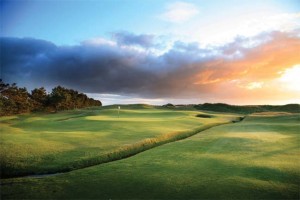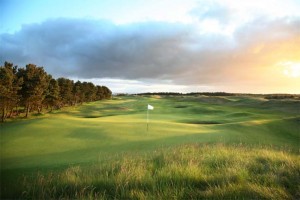It’s Monday – the first full day in Ayrshire for our Golf Road Warriors group. Angus McIntosh, our devoted and superlative PerryGolf driver and guide, has just picked us up at The Marine Hotel and brought us to our next field of battle.
Ayrshire is blessed with a bevy of fine links courses including the two at Turnberry (Ailsa and Kintyre), Royal Troon and Prestwick. Yesterday, we “played” the Ailsa, home of past Open Championships and one of the finest links courses anywhere, in a howling gale.
Today we’ll begin at a course that is less well known – but shouldn’t be. The Kyle Phillips-designed course called Dundonald Links sits just 10 miles from Prestwick Airport — directly across the railroad tracks from Western Gailes GC. It is every inch a championship course, and though it’s only about a decade old, it has the feel of an old, classic links with pot bunkers to avoid, wee burns to be carried on approach shots, gorse aplenty and 18 subtle but vexing greens.
It is, in my opinion, Scotland’s most underrated links course.
Originally called Southern Gailes, the course’s name was changed to reflect the history of the site in 2003 when it was acquired by the members of Loch Lomond Golf Club, who wanted to add a links course that would be playable in winter months to their club offerings. Dundonald means ‘Fort Donald.’ There’s a hill near the course where fortifications have been located dating back to the period 500 through 200 B.C. Three castles succeeded those original structures and in the early 1900s there was an old golf course named Dundonald on the site of the new course. It was converted to military use during World War II, at which time it was known as Dundonald Camp, and was used to rehearse the D-Day landings.
Today, the course is recognized by true aficionados as one of the more stout links tests in western Scotland. It has served as a pre-qualifying site for European Tour events, as well as the Senior Open Championship. It is a true championship course — something that cannot be said for some of its more celebrated Scottish kin. Phillips, whose other notable designs include Kingsbarns and The Grove, set out to create a classic links course here and Dundonald Links certainly looks and plays a lot like its storied neighbors. But in my mind, it’s a bit longer, broader and brawnier. It’s a large-scale links that will ask you to hit solid tee shots and use most of the irons (and hybrids and fairway woods) in your bag.
Position off the tee is important here. Most of the fairways are wide-ish, giving you the impression that anywhere in the fairway will do. But this is usually not the case – and you need to beware hidden bunkers off the tee and judge distances to doglegs carefully, too. Around the greens, you also have your work cut out for you. Phillips is a magician when it comes to taking a relatively boring piece of land and with the addition of some shaping, a few pot bunkers, and imaginative green designs turning it into a series of great golf holes. There are more than a dozen of them here. Conditions at Dundonald are uniformly excellent and the greens typically run fast and true. Short-side yourself and you’ll be in trouble. Find one of the course’s many greenside pot bunkers and you’ll need a deft touch to get up and down. And if I were you, I’d try real hard to avoid the fairway pot bunkers. They’re automatic one-stroke penalties.
Even on straightforward holes, like the par-4 9th, what appears to be a driver-wedge kind of hole becomes a bit more menacing when you realize that the green is a very shallow one, and that you’ll need to judge your distance precisely and spin your approach shot well for it to hit and hold this green.
Some of my favorite holes at Dundonald include the par-5 3rd, where your second (or third) shot will have to carry a nagging burn; the beautiful par-3 6th, with its sweeping green; the dogleg-left 7th, a par 4 that just dares you to take the short route off the tee; the dogleg-left 10th, a long par 4 that demands two sterling shots for par to be achieved; the short 13th, where your approach shot must carry a burn and stay on a sharply sloping green; the 15th – the course’s longest par 3 at 205 yards; and the finishing hole, a par 5 with a smallish green protected by a burn.
Guy Redford, Director of Golf at Dundonald, says that lately the course has been busiest in winter. That’s because Dundonald not only serves as the winter course for Loch Lomond Golf Club members, it serves as the home course for Glaswegians and most of the rest of southwestern Scotland when cold temps come to their home towns and golf is still being played at Dundonald — as it is all winter.
When we arrived there this morning, it looked like yesterday’s torrential rain might find us again. But by the third hole, the sun came out, the rain gear came off, and we were treated to what is truly one of my favorite links courses in this part of Scotland. Dundonald asks you to pay attention every step of the way. In return, you’re rewarded with a course that will delight you, torment you, ask you to do more than you can do, and leave you feeling like you’ve gone to battle like a true (Golf Road) warrior.
Next time you’re in this area, do yourself a favor and discover this course. And tell your friends about it. This is one seriously good golf course. Just because they haven’t held The Open there (yet) doesn’t mean it shouldn’t be on your itinerary. I’m telling you — you need to play it.
To read about more of the Golf Road Warriors Scotland adventures, click here.



